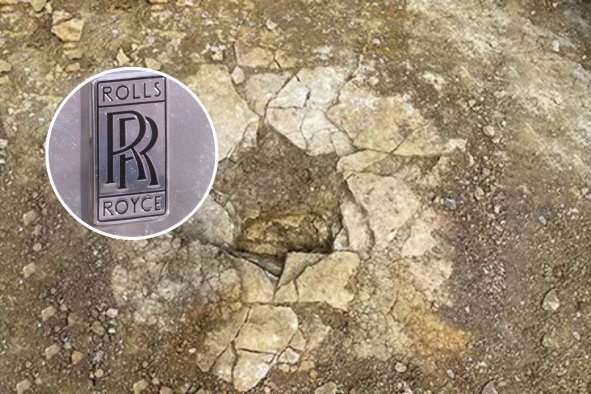Restoration work on a metal artifact found in Berlin, Germany, has revealed it to be an "ornately decorated" Japanese sword that possibly dates to the 17th century.
The object was uncovered in the winter of 2022 during excavations being carried out in the vicinity of Berlin's Molkenmarkt—the oldest square in the city—along the neighboring Stralauer Straße (Stralauer Street), State Museums of Berlin announced in a news release.
The excavations in Stralauer Straße were initiated because new power lines had to be laid in the ground below the street. The metal object was spotted in the cellar of a former house amid rubble dated to the Second World War.
"Like so many houses in Berlin, the house in Stralauer Straße was destroyed in the final days of the Second World War, rendering it unusable. The cellar vaults were filled with rubble and numerous military artifacts, apparently belonging to the artillery," Matthias Wemhoff, director of the Museum for Pre- and Early History of the State Museums of Berlin, told Newsweek.
"In the 1960s, Stralauer Straße was extremely widened. The cellar vaults of the former residential and commercial buildings lay beneath the current street. The sword must have found its way into the cellar with the war debris when the houses were destroyed," he said.
The object was originally found in a heavily corroded state and resembled simply an elongated "lump of iron," according to Wemhoff.
At first glance, archaeologists suspected that it could be a parade saber—a type of ceremonial sword—like those worn by German officers during WWII, which would have been consistent with the other artifacts found in the cellar.
The object was subsequently sent to museum experts, who then carried out restoration work on the artifact.
"It was only in the restoration workshops of our museum that the true significance and origin of the sword was recognized after the first careful removal of rust," Wemhoff said.
These efforts surprisingly revealed the object to be a type of Japanese short sword—known as a wakizashi—which had been preserved in fragments. The sword features a hilt motif of Daikoku, one of the Seven Lucky Gods of Japanese mythology, identifiable by his symbols of the hammer and sack of rice.
Furthermore, the restoration also revealed enameled ornamentation featuring chrysanthemum motifs on the guard. Judging by the motifs and style, it was possible to date the hilt to Japan's Edo period, which lasted from the 17th to 19th centuries. The hilt of a sword consists of the guard, grip and pommel—a structure found at the end, serving as a counterweight.
Analysis of the weapon indicated that the blade was originally longer and appears to be significantly older than the hilt—potentially even dating back to the 16th century.
"The much older blade of the sword indicates that the original sword was cared for and preserved for a long time. It may even have been passed down as a family heirloom over many generations before it was used for a second time when the blade was shortened and a new handle was added, before finally arriving in Germany," Wemhoff said.
"The discovery of the wakizashi sword is significant in that it sheds light on a long-forgotten or little-noticed episode in our history and that of our city."
A wakizashi is shorter than a katana—another type of Japanese sword. The samurai always carried both swords, wakizashi and katana, together. Only they were allowed to carry such a pair of weapons, according to Wemhoff, although the wakizashi sword could also be carried as a single sword by other dignitaries.
During the Edo period, from which the sword's hilt dates, military rulers known as the shoguns effectively controlled Japan and isolated the country from the rest of the world. The Meiji Restoration in 1868—a political event that restored practical imperial rule to Japan under Emperor Meiji—sealed the end of the shogunate and suddenly opened up the country.
In search of suitable political structures for the new Japan, Japanese delegations traveled the world, including two visits to the Prussian court in the Berlin Palace (1862 and 1873).
It is not known how exactly the wakizashi sword ended up in Berlin—and ultimately in the residential cellar. But one of the several possible interpretations is that the sword was a gift from one of the two Japanese delegations that visited Berlin in the 1900s.
"However, it could just as well have been brought by German travelers who visited Japan in 1860-61 as part of the Prussian East Asia Expedition to conclude the first friendship treaties there. In the 19th century, the sword was already an antique and not very suitable as a gift for guests due to its long period of use and alteration. It is therefore more likely that it came to Berlin as a souvenir from European travelers, or was brought to Berlin by Japanese travelers—there were also Japanese students at Berlin University in the 19th century," Wemhoff said.
"This discovery is yet another example of the surprising artifacts that are waiting to be unearthed beneath the soil of Berlin. Who could have imagined that such a well-used and ornately decorated weapon would make its way to Berlin at a time when Japan was effectively shut off to the outside world and barely any European travelers visited the country?" Wemhoff said in the news release.
Do you have a tip on a science story that Newsweek should be covering? Do you have a question about archaeology? Let us know via science@newsweek.com.
Disclaimer: The copyright of this article belongs to the original author. Reposting this article is solely for the purpose of information dissemination and does not constitute any investment advice. If there is any infringement, please contact us immediately. We will make corrections or deletions as necessary. Thank you.




